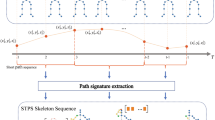Abstract
Action recognition plays a fundamental role in many applications and researches, including man-machine interaction, medical rehabilitation and physical training. However, existing methods realize action recognition mainly relies on the background. This paper attempts to recognize the actions only through the motions. Hence, skeleton information is utilized to realize action recognition. To fully utilize the skeleton information, this paper proposes a discriminative spatio-temporal graph convolutional network (DSTGCN) for background independent action recognition. DSTGCN not only pays attention to the spatio-temporal properties of the motions, but focuses on the inner-class distributions of the actions. Experiments result on two motion oriented datasets validate the effectiveness of the proposed method.
This study was funded by National Natural Science Foundation of Peoples Republic of China (61672130, 61972064), The Fundamental Research Funds for the Central Universities (DUT19RC(3)012, DUT20RC(5)010) and LiaoNing Revitalization Talents Program (XLYC1806006).
Access this chapter
Tax calculation will be finalised at checkout
Purchases are for personal use only
Similar content being viewed by others
References
Carreira, J., Zisserman, A.: Quo vadis, action recognition? A new model and the kinetics dataset. In: proceedings of the IEEE Conference on Computer Vision and Pattern Recognition, pp. 6299–6308 (2017)
Duric, Z., et al.: Integrating perceptual and cognitive modeling for adaptive and intelligent human-computer interaction. Proc. IEEE 90(7), 1272–1289 (2002)
Guo, S., et al.: Multi-view laplacian least squares for human emotion recognition. Neurocomputing 370, 78–87 (2019)
Huang, G., Liu, Z., Van Der Maaten, L., Weinberger, K.Q.: Densely connected convolutional networks. In: Proceedings of the IEEE Conference on Computer Vision and Pattern Recognition, pp. 4700–4708 (2017)
Ji, S., Xu, W., Yang, M., Yu, K.: 3D convolutional neural networks for human action recognition. IEEE Trans. Pattern Anal. Mach. Intell. 35(1), 221–231 (2012)
Jiang, B., Wang, M., Gan, W., Wu, W., Yan, J.: STM: spatiotemporal and motion encoding for action recognition. In: Proceedings of the IEEE International Conference on Computer Vision, pp. 2000–2009 (2019)
Ke, Q., Bennamoun, M., An, S., Sohel, F., Boussaid, F.: A new representation of skeleton sequences for 3D action recognition. In: Proceedings of the IEEE Conference on Computer Vision and Pattern Recognition, pp. 3288–3297 (2017)
Kong, Y., Fu, Y.: Bilinear heterogeneous information machine for RGB-D action recognition. In: Proceedings of the IEEE Conference on Computer Vision and Pattern Recognition, pp. 1054–1062 (2015)
Li, M., Chen, S., Chen, X., Zhang, Y., Wang, Y., Tian, Q.: Actional-structural graph convolutional networks for skeleton-based action recognition. In: Proceedings of the IEEE Conference on Computer Vision and Pattern Recognition, pp. 3595–3603 (2019)
Lin, T.Y., Goyal, P., Girshick, R., He, K., Dollár, P.: Focal loss for dense object detection. In: Proceedings of the IEEE International Conference on Computer Vision, pp. 2980–2988 (2017)
Liu, J., Shahroudy, A., Xu, D., Wang, G.: Spatio-temporal LSTM with trust gates for 3D human action recognition. In: Leibe, B., Matas, J., Sebe, N., Welling, M. (eds.) ECCV 2016. LNCS, vol. 9907, pp. 816–833. Springer, Cham (2016). https://doi.org/10.1007/978-3-319-46487-9_50
Liu, M., Liu, H., Chen, C.: Enhanced skeleton visualization for view invariant human action recognition. Pattern Recogn. 68, 346–362 (2017)
Liu, S., Guo, S., Wang, W., Qiao, H., Wang, Y., Luo, W.: Multi-view laplacian eigenmaps based on bag-of-neighbors for RGB-D human emotion recognition. Inf. Sci. 509, 243–256 (2020)
Liu, S., et al.: FSD-10: a dataset for competitive sports content analysis. arXiv preprint arXiv:2002.03312 (2020)
Shahroudy, A., Liu, J., Ng, T.T., Wang, G.: NTU RGB+ D: a large scale dataset for 3D human activity analysis. In: Proceedings of the IEEE Conference on Computer Vision and Pattern Recognition, pp. 1010–1019 (2016)
Shi, L., Zhang, Y., Cheng, J., Lu, H.: Two-stream adaptive graph convolutional networks for skeleton-based action recognition. In: Proceedings of the IEEE Conference on Computer Vision and Pattern Recognition, pp. 12026–12035 (2019)
Wang, P., Li, W., Gao, Z., Zhang, Y., Tang, C., Ogunbona, P.: Scene flow to action map: a new representation for RGB-D based action recognition with convolutional neural networks. In: Proceedings of the IEEE Conference on Computer Vision and Pattern Recognition, pp. 595–604 (2017)
Wen, Y., Zhang, K., Li, Z., Qiao, Y.: A discriminative feature learning approach for deep face recognition. In: Leibe, B., Matas, J., Sebe, N., Welling, M. (eds.) ECCV 2016. LNCS, vol. 9911, pp. 499–515. Springer, Cham (2016). https://doi.org/10.1007/978-3-319-46478-7_31
Yan, S., Xiong, Y., Lin, D.: Spatial temporal graph convolutional networks for skeleton-based action recognition. arXiv preprint arXiv:1801.07455 (2018)
Yu, M., Liu, L., Shao, L.: Structure-preserving binary representations for RGB-D action recognition. IEEE Trans. Pattern Anal. Mach. Intell. 38(8), 1651–1664 (2015)
Author information
Authors and Affiliations
Corresponding author
Editor information
Editors and Affiliations
Rights and permissions
Copyright information
© 2020 Springer Nature Switzerland AG
About this paper
Cite this paper
Feng, L., Yuan, Q., Liu, Y., Huang, Q., Liu, S., Li, Y. (2020). A Discriminative STGCN for Skeleton Oriented Action Recognition. In: Yang, H., Pasupa, K., Leung, A.CS., Kwok, J.T., Chan, J.H., King, I. (eds) Neural Information Processing. ICONIP 2020. Communications in Computer and Information Science, vol 1333. Springer, Cham. https://doi.org/10.1007/978-3-030-63823-8_1
Download citation
DOI: https://doi.org/10.1007/978-3-030-63823-8_1
Published:
Publisher Name: Springer, Cham
Print ISBN: 978-3-030-63822-1
Online ISBN: 978-3-030-63823-8
eBook Packages: Computer ScienceComputer Science (R0)




